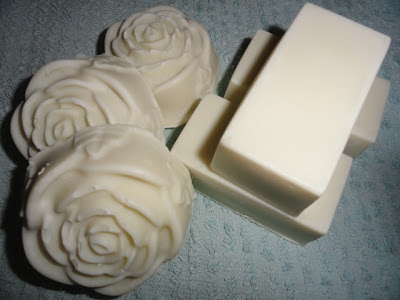I have been very busy lately making soap, while Hanno has been wrapping it and packaging it up to post all over Australia, the US and UK. Thanks to everyone who placed an order for soap or something I made. It is helping us with our finances and makes us feel good to be earning money selling what we've made with our own hands. I was very pleased to receive the first re-order from someone who bought the soap and wanted more. It makes me feel good knowing that something that helps us live well here can help others too.
One of the things I needed to do when I started selling the soap was to simplify the process. I needed it to be simpler and quicker without losing the quality I expect and want to pass on to you. I also wanted a recipe that would use a full packet of *copha. I didn't want little pieces of copha floating around in our fridge. So I came up with a new recipe. It has only four ingredients - olive oil, coconut oil, rain water and caustic soda/lye. It took a while to get the mix right because I had to test all of them on myself, so although the simplifying process took a long time, it's easier now to make the soap. I'm trying to make a batch every couple of days.
*copha is solidified coconut oil which works well if you can't find liquid coconut oil, or if it's too expensive. You can buy copha in most Australian supermarkets in the butter section. It's currently $2.66 for the amount you'll need for this recipe.
*copha is solidified coconut oil which works well if you can't find liquid coconut oil, or if it's too expensive. You can buy copha in most Australian supermarkets in the butter section. It's currently $2.66 for the amount you'll need for this recipe.
I am happy to share the new recipe with you. Please be guided by all the warnings I've written about here and the use the same method for making the soap. Click on the link to go to the warnings and the post on how to make soap.
The new recipe is:
- 450 mls * rain water
- 172 grams caustic soda/lye
- 1000 grams olive oil
- 250 grams copha or coconut oil
* If you don't have rain water, collect enough tap water the day before you make the soap and leave it on the bench to sit. That will allow the chlorine in the water to evaporate off.
If you don't operate in mls and grams, there is an online conversion calculator here.
If you don't operate in mls and grams, there is an online conversion calculator here.
If you've never made soap before, it's a great skill to have and it will give you and your family excellent soap that you can use on everyone from baby to grandpa, including everyone with sensitive skin. I use it to wash my hair too. I've used it for a few years now and my hair is healthy and shiny. No more expensive plastic shampoos for me. It's either my hand made soap or bicarb from now on.
Put simply, to make soap, you mix ingredients 1 and 2 together, give it a good mix and it will heat up without you putting it on the stove. You have to wait for it to cool down. While it is doing that, you add ingredients 3 and 4 to a saucepan and heat it up. You wait for 1 and 2 to cool to 50C/112F and you wait for 3 and 4 to heat up to 50c/112F. When both mixtures are at the same temperature, you combine them and mix. I use a stab blender and it comes together nicely. You can also use a mixer or hand stir it. What ever you use has to be able to mix without it splashing everywhere. When you reach "trace", and that is explained in the above link, with a photo, it's done. You pour it into your shapes, cover it so it cools slowly, and leave it. The next day you can take the soap out of the moulds and let them sit to cure and harden. But please, if you intend to make soap, do it when the children are in bed and there are no dogs and cats under foot, and make sure you read the guidelines in the link.
If you've been meaning to give soapmaking a go, if you've been wanting to add another simple string to your bow, this might interest you. If you want feedback on how you're going or if you just want someone to see your soap, take photos and start a thread about it at the forum. I'll make sure I look out for any of those threads and help as much as I can. I'm sure the other soap makers there will as well.
I wonder if this simplified recipe will encourage some new soap makers. :- )
PS: I spent yesterday at the neighbourhood centre doing a fermentation workshop. We made up sourdough starter, vinegar and ginger beer and everyone went home fired up and enthusiastic about future fermenting. It was great to see. Oh, and one of the ladies from the last workshop arrived with a huge bag of Seville oranges for me! Sevilles are the traditional orange for marmalade but you can't buy them in the shops here now because people aren't making enough marmalade. That's on my list now.
As usual, I'm running behind a bit so if you're expecting an email from me, or some soap, I'll be back on them again today. Please be patient with me.


